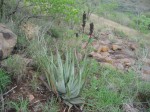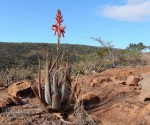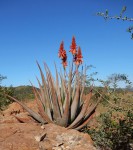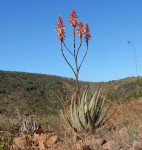| Home | > | List of families | > | Asphodelaceae | > | Aloe | > | pienaarii |
Aloe pienaarii
Selected images: Click on each image to see a larger version and details of the record View all images (5)
Detailed records: Display species records QDS maps by: Google Maps Point records by Google Maps
Species details: Click on each item to see an explanation of that item (Note: opens a new window)
| Synonyms: | |
| Common names: | |
| Frequency: | Locally frequent |
| Status: | Native |
| Description: |
Succulent herb, solitary or suckering to form small groups, stemless or with a very short stem. Leaves in a compact rosette, stiffly erect, up to 90 cm long, 12-15 cm wide at the base, grey-green, tinged reddish in dry conditions; margin with sharp 3-angular brown-tipped teeth. Inflorescences 1-3, erect, 1.25-1.75m high, 4-8-branched. Racemes very densely many-flowered, 25-50 cm long, narrowly cylindric-acuminate; bracts c. 20 × 6 mm, ovate-acuminate, many-veined. Flowers 50-45 mm long, 3-sided-cylindric, bright red, green-tipped in bud, sometimes yellow with a red base. |
| Type location: |
|
| Notes: | This species has long been considered synonymous with A. cryptopda but can be readily distinguished by the much larger and differently shaped floral bracts, generally larger plant size, more closely spaced marginal teeth, more densely flowered racemes and longer perianths |
| Derivation of specific name: | pienaarii: after P. J. Pineaar, who collected this species in 1914, near Pietersburg, in South Africa. |
| Habitat: | In sandy soils among rocks in deciduous woodland. |
| Altitude range: (metres) | 140 - 600 m |
| Flowering time: | Jun - Jul |
| Worldwide distribution: | Mozambique, Eswatini and Limpopo, Mpumalanga, South Africa. |
| National distribution: | M |
| Growth form(s): | |
| Endemic status: | |
| Red data list status: | |
| Insects associated with this species: | |
| Spot characters: | Display spot characters for this species |
| Images last updated: | Saturday 9 July 2016 |
| Literature: |
Carter, S. (2001). Aloaceae Flora Zambesiaca 12(3) Pages 95 - 97. (Includes a picture). Carter, S., Lavranos, J.J., Newton, L.E. & Walker, C.C. (2011). Aloes, The Definitive Guide Royal Botanic Gardens, Kew ISBN 978 1 84246439 7 Page 385. (Includes a picture). |
Other sources of information about Aloe pienaarii:
External websites:
African Plants: A Photo Guide (Senckenberg): Aloe pienaariiAfrican Plant Database: Aloe pienaarii
BHL (Biodiversity Heritage Library): Aloe pienaarii
EOL (Encyclopedia of Life): Aloe pienaarii
GBIF (Global Biodiversity Information Facility): Aloe pienaarii
Google: Web - Images - Scholar
iNaturalist: Aloe pienaarii
IPNI (International Plant Names Index): Aloe pienaarii
JSTOR Plant Science: Aloe pienaarii
Mansfeld World Database of Agricultural and Horticultural Crops: Aloe pienaarii
Plants of the World Online: Aloe pienaarii
Tropicos: Aloe pienaarii
Wikipedia: Aloe pienaarii
| Home | > | List of families | > | Asphodelaceae | > | Aloe | > | pienaarii |




